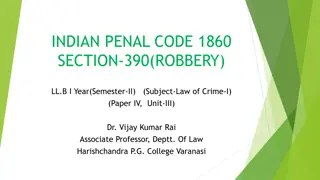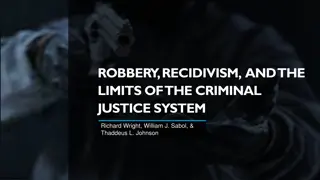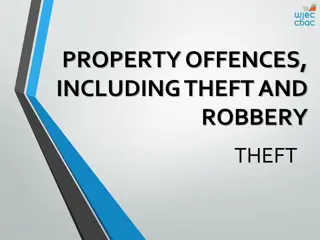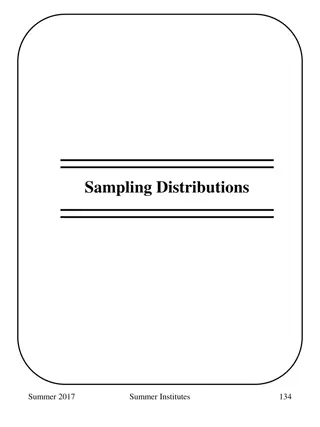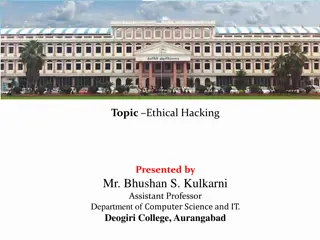Understanding Robbery: Elements, Definition, and Distinctions
Robbery, defined under Section 8 of the Theft Act 1968, involves the act of stealing with the use of force or threat of force. This offense carries serious consequences, including a potential life imprisonment sentence. The key elements of robbery include the actus reus of theft and force, along with the mens rea of intention to use force to carry out the theft. Distinguishing robbery from theft involves the presence of force or the fear of force at the time of the crime. Understanding these elements is crucial in differentiating robbery from simple theft and determining the severity of the offense.
Download Presentation

Please find below an Image/Link to download the presentation.
The content on the website is provided AS IS for your information and personal use only. It may not be sold, licensed, or shared on other websites without obtaining consent from the author. Download presentation by click this link. If you encounter any issues during the download, it is possible that the publisher has removed the file from their server.
E N D
Presentation Transcript
PROPERTY OFFENCES, INCLUDING THEFT AND ROBBERY Robbery
Robbery Defined in Section 8 Theft Act 1968: A person is guilty of robbery if he steals and immediately before or at the same time of doing so and in order to do so, he uses force on any person or seeks to put them in fear of being then and there subjected to force. It is an indictable offence meaning it is triable on indictment in the Crown Court. It is a more serious offence than theft. It can carry a life imprisonment sentence though this is the maximum. Some have called it aggravated theft as it involves the offence of theft PLUS force or the threat of force.
The elements of Robbery A theft Immediately before or at the same time as stealing Uses force or there is a threat of force On any person The force or threat of force is in order to steal. Actus reus = theft and force or putting or seeking to put any person in fear of force. Mensrea = mens rea of theft and intention to use force in order to thieve.
Elements of Robbery -Theft ALL of the elements of theft must be present for there to have been a robbery. If one element is missing there is no robbery as confirmed in the case of R v Robinson (1977). To recap, the elements of theft as defined in section 1 Theft Act 1968 are: Dishonestly Appropriates Property Belonging to another Intention to permanently deprive the other of it.
Elements of Robbery For it to be a robbery and not a simple theft, force needs to be used at the time of the theft or immediately before it. Once the theft is then complete there is a robbery. This was confirmed in the case of Corcoran v Anderton (1840). In this case, had the theft not been completed (e.g. the woman keeps hold of the bag and does not let the attackers take it) there is only an attempted robbery.
Elements of Robbery Force or threat of the use of force Force (or threat of) distinguishes robbery from theft. It is a question for the jury to decide. It can include a small amount of force as confirmed in the case of Dawson and James (1976) and confirmed in Clouden (1987). This case also confirmed that the force did not necessarily have to be applied to a person (e.g. if a thief forcibly pulls a bag from a person s shoulder). However, it may not be considered to be force as required by robbery if for example a bag fell away from a person s shoulder or if a thief grabbed a bag that was resting on a person s lap.
Force or threat of use of force There needs to be force or a fear that force will be used in carrying out the theft. This establishes that it is not a requirement that the force be applied. A fear of force through a threat is sufficient. E.g. I have a baseball bat which I will beat you with unless you give me your iPhone would be sufficient for fear of force. A gesture such as holding a gun to someone s head would also be sufficient.
The force has to be used immediately before or at the time of the theft E.g. if an armed gang go to a manager s house and forcibly steal keys from him to a store room where expensive equipment is contained and then drive to the store to complete the theft, is this immediate enough? This probably would be. However, if the delay was longer, e.g. they wait a day before breaking in to the store room, then this delay would probably be too long. Judges needs to determine this issue but there have been no decided cases on the matter. Also, the definition seems to imply that force needs to be used at the time of stealing . In the case of Hale (1979) it was decided that the force immediately before the stealing and the ongoing theft was sufficient for the definition. This rationale was followed in the case of Lockley (1995).
On any person The theft does not have to happen from the person being actually threatened. For example in an armed bank robbery a random customer in the bank that is being held up would be in fear of force being used against them but the money stolen would be the bank s property.
The force or threat of force is in order to steal The force used must be in order to carry out the theft e.g. two people have a fight where the defendant punches the victim. He then proceeds to steal his wallet and phone which have landed on the floor during the fight. This would not be a robbery as the force was not used to steal. It would potentially be two separate offences of theft and a non-fatal offence. So now that we have considered the actus reus of theft, what is the mens rea?
MensRea of Robbery Mens rea of robbery = mens rea of theft (dishonest and intend to permanently deprive the other of the property) + intention to use force to steal.









